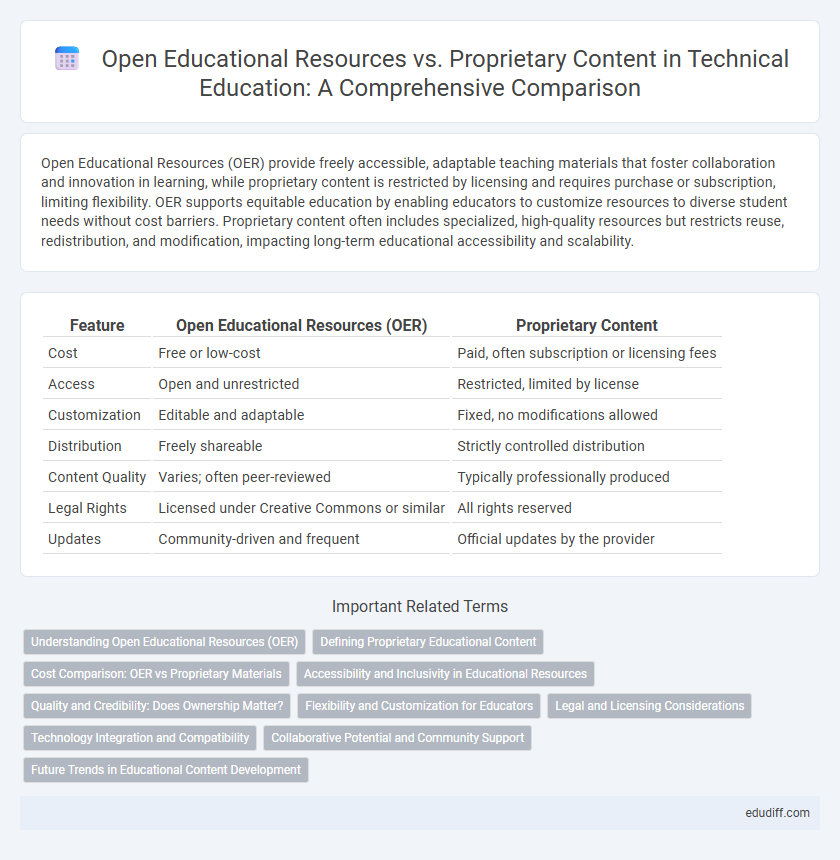Open Educational Resources (OER) provide freely accessible, adaptable teaching materials that foster collaboration and innovation in learning, while proprietary content is restricted by licensing and requires purchase or subscription, limiting flexibility. OER supports equitable education by enabling educators to customize resources to diverse student needs without cost barriers. Proprietary content often includes specialized, high-quality resources but restricts reuse, redistribution, and modification, impacting long-term educational accessibility and scalability.
Table of Comparison
| Feature | Open Educational Resources (OER) | Proprietary Content |
|---|---|---|
| Cost | Free or low-cost | Paid, often subscription or licensing fees |
| Access | Open and unrestricted | Restricted, limited by license |
| Customization | Editable and adaptable | Fixed, no modifications allowed |
| Distribution | Freely shareable | Strictly controlled distribution |
| Content Quality | Varies; often peer-reviewed | Typically professionally produced |
| Legal Rights | Licensed under Creative Commons or similar | All rights reserved |
| Updates | Community-driven and frequent | Official updates by the provider |
Understanding Open Educational Resources (OER)
Open Educational Resources (OER) are teaching, learning, and research materials freely available for use and repurposing, often licensed under Creative Commons to ensure accessibility and adaptability. Unlike proprietary content, which requires purchase or subscription, OER promotes equitable access to education by eliminating cost barriers and enabling customization to diverse learning needs. Implementing OER in educational environments fosters collaboration, innovation, and continuous improvement through shared pedagogical resources.
Defining Proprietary Educational Content
Proprietary educational content refers to learning materials owned and controlled by an individual or organization, often protected by copyright and licensing agreements. Access to this content typically requires purchase or subscription, restricting redistribution and modification. These limitations contrast with Open Educational Resources (OER), which allow free use, adaptation, and sharing to promote accessible and collaborative education.
Cost Comparison: OER vs Proprietary Materials
Open Educational Resources (OER) provide a significant cost advantage over proprietary materials by offering free or low-cost access to textbooks, courseware, and multimedia content, reducing financial barriers for students and institutions. Proprietary content often involves substantial licensing fees and recurring costs, which can escalate educational expenses and limit accessibility. Institutions leveraging OER can allocate budget savings towards enhancing instructional quality and expanding educational offerings.
Accessibility and Inclusivity in Educational Resources
Open Educational Resources (OER) enhance accessibility by offering free, modifiable materials that accommodate diverse learning needs and disabilities, supporting inclusivity across socioeconomic backgrounds. Proprietary content often restricts access through licensing fees and limited customization, creating barriers for learners with varying abilities and financial constraints. Leveraging OER promotes equitable education by enabling adaptive technologies and multilingual formats, fostering broader participation and engagement.
Quality and Credibility: Does Ownership Matter?
Open Educational Resources (OER) often undergo peer review and collaborative updates, enhancing their quality and credibility through transparent authorship and collective expertise. Proprietary content, managed by commercial entities, typically benefits from rigorous editorial standards and consistency driven by competitive market demands. Ownership impacts quality control mechanisms and trustworthiness, with OER promoting openness and adaptability, while proprietary content ensures accountability through centralized content governance.
Flexibility and Customization for Educators
Open Educational Resources (OER) offer unparalleled flexibility and customization, enabling educators to adapt materials to diverse learning needs without legal or financial constraints. Proprietary content often restricts modification, limiting educators' ability to tailor resources for specific curricula or student demographics. The open licensing of OER facilitates continuous updates and integration of interactive technologies, enhancing pedagogical effectiveness in dynamic educational environments.
Legal and Licensing Considerations
Open Educational Resources (OER) utilize Creative Commons licenses that enable free use, adaptation, and distribution, fostering collaboration and innovation while ensuring legal clarity. Proprietary content is restricted by traditional copyright laws, requiring explicit permissions or licenses for use, often involving fees and limiting flexibility. Understanding these licensing frameworks is crucial for institutions aiming to balance accessibility, compliance, and intellectual property protection.
Technology Integration and Compatibility
Open Educational Resources (OER) offer seamless technology integration due to their open formats and adaptable licenses, facilitating compatibility across diverse Learning Management Systems (LMS) and digital platforms. Proprietary content often relies on restricted formats and proprietary software, limiting interoperability and complicating integration with emerging edtech tools. Emphasizing open standards in OER enhances scalability and flexibility, driving more efficient adoption and customization compared to the rigid frameworks typical of proprietary educational materials.
Collaborative Potential and Community Support
Open Educational Resources (OER) foster collaborative potential through open licensing, enabling educators and learners to adapt, share, and co-create content freely, which enhances community-driven innovation and continuous improvement. Proprietary content often limits collaboration due to restrictive usage rights and lack of transparency, hindering collective input and resource customization. Community support thrives in OER ecosystems where diverse stakeholders contribute expertise and feedback, driving dynamic content evolution and localized relevance.
Future Trends in Educational Content Development
Open Educational Resources (OER) are increasingly integrated with adaptive learning technologies and AI-driven content personalization, enhancing accessibility and customization in education. Proprietary content providers are investing in immersive experiences such as VR and AR to deliver interactive and engaging learning modules. Future trends indicate a convergence where OER platforms adopt proprietary innovations, promoting hybrid models that balance cost-effectiveness with advanced technological features.
Open Educational Resources vs Proprietary Content Infographic

 edudiff.com
edudiff.com